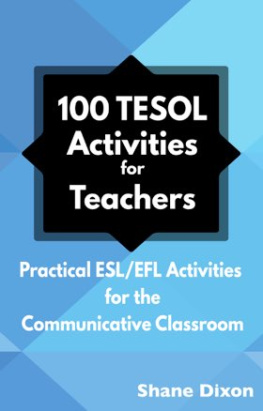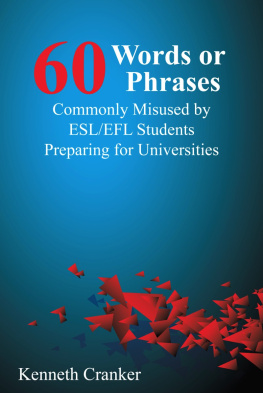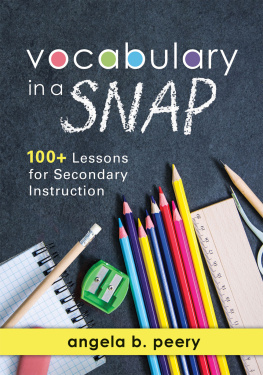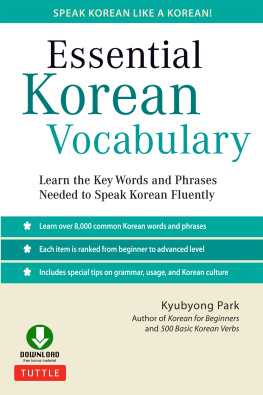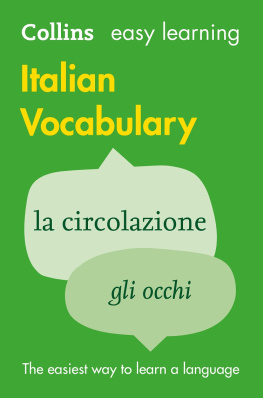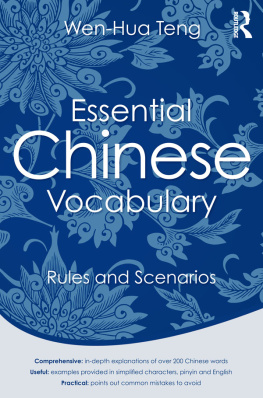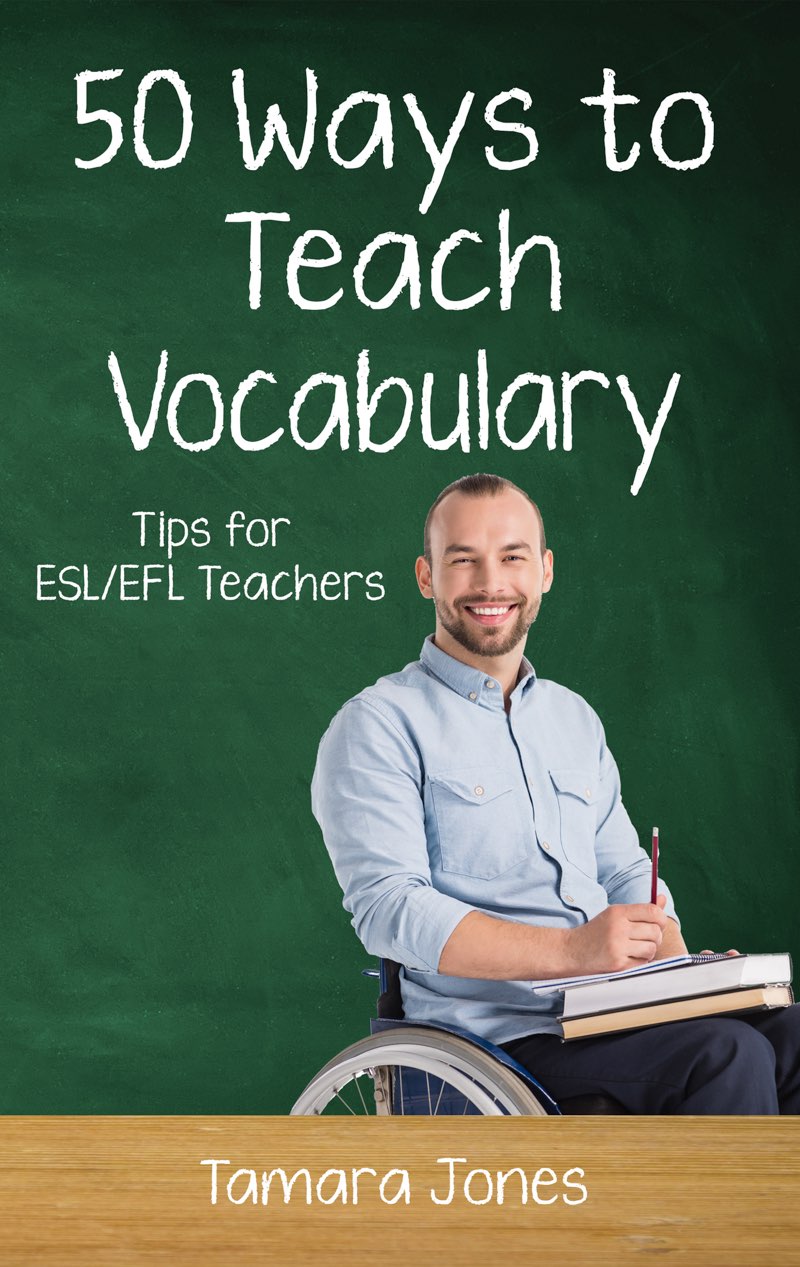All rights reserved. No part of this publication may be reproduced, stored in or introduced into a retrieval system, or transmitted, in any form, or by any means (electronic, mechanical, photocopying, recording, or otherwise) without the prior written permission of the copyright owner.
Cover design by DJ Rogers.
Edited by Dorothy Zemach.
Published in the United States by Wayzgoose Press.
How To Use This Book
Most teachers use a textbook in class, which provides both instruction and practicebut, often, not enough practice. Students need to practice again and again, and in different ways, not just to keep their interest but to both learn and remember.
This book gives you ideas to help your students become proficient at learning and remembering vocabulary in English. It can be used with any textbook, or without any textbook at all. It tells you how to adapt and extend exercises; it gives you games and warm-ups that can be added to any class; it gives you methods to practice both accuracy and fluency.
Not every idea will work for every student or for every class. Thats why there are fifty. We feel sure that many of the ideas presented here will bring you results if you try them sincerely and practice them regularly.
Here is a suggested method for using this book:
- Read through all of the fifty tips without stopping.
- Read through the tips again. Choose five or six that you think might work for your class. Decide when you will try them.
- Choose different types of ideas: some that can be done independently, and some that work along with your textbook.
- Each time you use one of the ways, make a note about how well it worked for your class and why. Remember that most of the tips will work best if you use them several times (or even make them a habit). Dont try a tip only once and decide its no good for your students. Give the tips you try a few chances, at least.
- Every few weeks, read through the tips again, and choose some new ones. Discontinue using any methods that are not working for you
Finally, consider trying some of the other books in our 50 Ways to Teach series. No one skill in English is really separate from the others. Speaking, listening, reading, writing, vocabulary, and grammar are all connected. Students who improve in one area will almost always improve in other areas too.
Introduction
This book is both for teachers who are new to ESL/EFL and teachers who are looking for more interactive activities for their English classes. This isnt an exploration of research and pedagogy, but a list of activities and tips for making activities more effective.
Not all these ways may work for your class exactly as written. However, it is always a good idea to look at an idea and think about how you could adapt it to fit your own context. When you read an idea, think about how you could change it to fit your students ages, levels, culture, and interests. Please feel free to adapt the activities in any way you like.
When considering trying the activities in this book, think about your course goals and objectives and which activities would be most useful in helping you reach them. Some of these activities can be modified to accompany or supplement a textbook; others provide opportunities to go beyond what your textbook might provide.
This book is divided into five sections:
- Introducing New Vocabulary: Whole Class Activities
- Introducing New Vocabulary: Small Group and Individual Work
- Reviewing & Remembering: Whole Class Activities
- Reviewing & Remembering: Small Group and Individual Work
- Assessing Learning
The activities are not divided by proficiency level because the vast majority of them can be used with students at all stages of language acquisition, provided the vocabulary is learner-appropriate.
Vocabulary is the foundation of successful language learning. Plainly put, ESL/EFL learners need to be familiar with a great many words if they want to read, write, listen, or speak with ease. There are over one million words in the English language, and students need to know at least 8,000 word families in order to function comfortably (Schmitt, N., 2008). In fact, research by Hu and Nation (2000) shows students need to understand 98% of the words in a text to adequately understand it, and Bonk (2000) suggests that students need to know 95% of the words they hear to comfortably understand what someone is saying.
In addition to the sheer number of words and phrases students need to learn, what makes vocabulary acquisition so tricky is that one pass is never enough. Nation (2001) argues that students need to engage with a word between 5 and 20 times in order to learn it. In order to really know a word, learners need to know, among other things, how to spell it, how to pronounce it, what other words it collocates with, what prefixes and suffixes it takes, what grammatical patterns it fits with, and what positive or negative associations it may have (Folse, 2004). That means, not only do teachers need to carefully select the words that would be most useful for our students, but we also need to give them as many opportunities for varied practice as possible.
Moreover, brain research (Caine and Caine, 2001) reveals that students learn the most easily when they are interested and having fun. Games and activities that engage students, whether they are adults or children, will help them create stronger memories and store these memories for longer. Therefore, the practice we provide should not be limited to the gap fills and matching activities that our textbooks contain. Instead, in order to help our students learn the vocabulary necessary for communication, teachers need to offer activities that are engaging and which create powerful emotional memories of these words.
You can find the templates to use with some of the tips at: http://anglofile.com/50ways/. You are free to photocopy and distribute these worksheets.
Bonk, W. J. (2000). Second language lexical knowledge and listening comprehension. International Journal of Listening, 14, 1431.
Caine, G. and Caine, R.N. (2001). Making Connections: Teaching and the Human Brain. Lebanon, IN: Dale Seymour Publications.
Folse, K. (2004) Vocabulary Myths: Applying Second Language Research to Classroom Teaching. Ann Arbor: University of Michigan Press.
Hu, M., & Nation, I.S.P. (2000). Vocabulary density and reading comprehension. Reading in a Foreign Language, 13(1), 403430.
Nation, I. S. P. (2001). Learning Vocabulary in Another Language. Cambridge: Cambridge University Press.
Schmitt, N. (2008). Instructed Second Language Vocabulary Learning. Los Angeles, London, New Delhi and Singapore: SAGE Publications.

